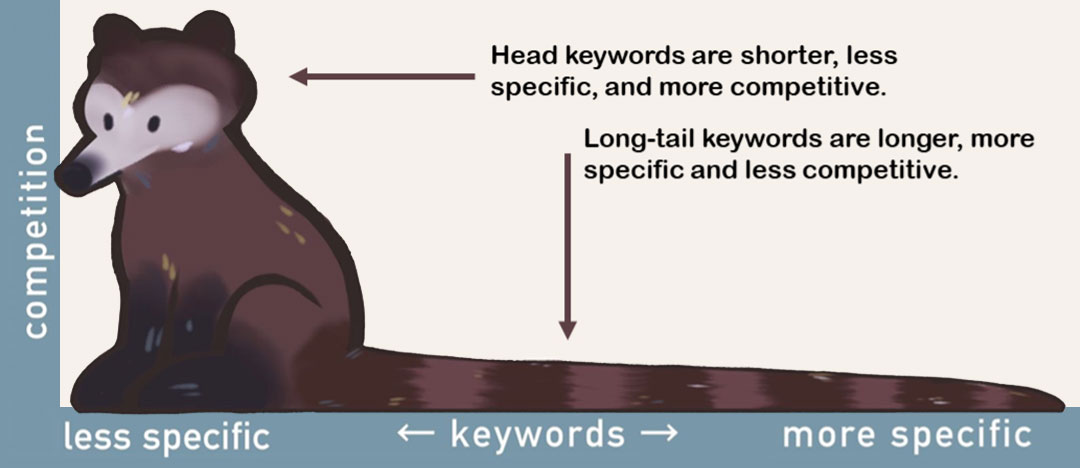Improve Your SEO Results With Long-Tail Keywords

If one of your New Year’s resolutions is improving your website’s online visibility, try focusing on long-tail keywords. Using long-tail keywords is a great SEO strategy because they are less competitive to rank for and often convert at a higher rate.
What Are Long-tail Keywords?
The term long-tail keyword came from the book The Long Tail by Chris Anderson. Long-tail keywords are more specific than common keywords. The phrase “long-tail” is a visual metaphor for the shape of a distribution on a response graph. The graph looks like it has a small hump at the front, which is the head, made up of short, broad, categorical terms, followed by an extended tail comprised of longer specific phrases that more accurately describes what a potential buyer is looking for in greater detail.
If you used the categorical, mainstream phrase “bathing suites” for example, you would need to outperform 28,600,000 competitive entries to appear on Google’s first few results pages. The term “bathing suites” would represent the head keyword phrase in a response graph. Specifying a unique type of bathing suit, such as an “anatomy bathing suit” would reduce the universe of results down to1,080 entries, and move you into the tail of the graph. Honing your search even further by using the phrase “human anatomy one piece swimsuit” would whittle your competition down to a mere 644 entries and resemble your search intent more closely. The chances of buyers finding specifically what they are looking for increase exponentially by becoming more granular, descriptive, and detailed.
Benefits Of Using Long-tail Phrases
When battling against competitive goliaths that have the resources and budgets to dominate search result pages, it is still possible to beat them by using long-tail keyword phrases that more closely align with your buyer’s end goal. There are many benefits to utilizing long-tail keywords, but the top two are effectiveness and efficiency.
- Effectiveness: Give users what they want. Shorter head keywords attract more website traffic, but not without enormous effort because the competition for these keywords is fierce. Even when you can lure potential buyers to your site, those who land on your page may not find what they are looking for because the term used to attract their attention was so broad in nature. While you might draw less traffic with a long-tail keyword phrase than you would with a more generic phrase, you’ll precisely attract the audience you’re looking for, and the audience would be far closer to finding exactly what they want.
- Efficiency: Less competition = lower costs. Long-tail keywords are as valuable for businesses who want their content to rank in organic Google searches as they are to advertisers running paid search marketing campaigns. This is because when you bid on long-tailed keywords, the cost per click is lower. By targeting longer, more specific keywords in your AdWords campaigns, you can get higher ad rankings on relevant searches without having to pay a premium for every click. The more specific your search terms are, the less competitive and easier it is to rank.
How To Find Long-Tail Keywords
If you recognize the value of long-tail keywords, consider utilizing these approaches when taking your first steps to implement them.
- Try to get into the heads of your audience. The goal at this stage is to look for onramps to the ways your products could be found based on what potential buyers are thinking. For example, think about what problems your products solve. Generate all the different ways people refer to your product(s). Identify your company’s competitive advantages and use these descriptions as food for thought as well.
- Type your findings into a search box and analyze your findings. After typing your findings into a search box, what appears on the search result pages will lead you down a confirmation path where you would go deeper in the direction you started; a tangential path where you refine your thoughts based on the results; or a new path because your findings indicate that you were on the wrong track.
- Expand your head keywords into long-tail variations. Once you’ve determined which path to take, feed your head keywords into a research tool like WordStream, Semrush, or Wordtracker, for long-tail phrases you could use.
Start Using Long-Tail Keywords Today
Focusing onsite SEO with these hyper-targeted keyword sets can help you punch above your weight class to improve SERP performance – which is especially important for companies with smaller budgets. It doesn’t take as much effort to get your pages to rank well for your targeted long-tail keywords and the leads will be better qualified.
If long-tail keyword phrases are not an integral underpinning to your SEO strategy because of the effort required to implement them, there are subject matter experts who can do the work for you.
